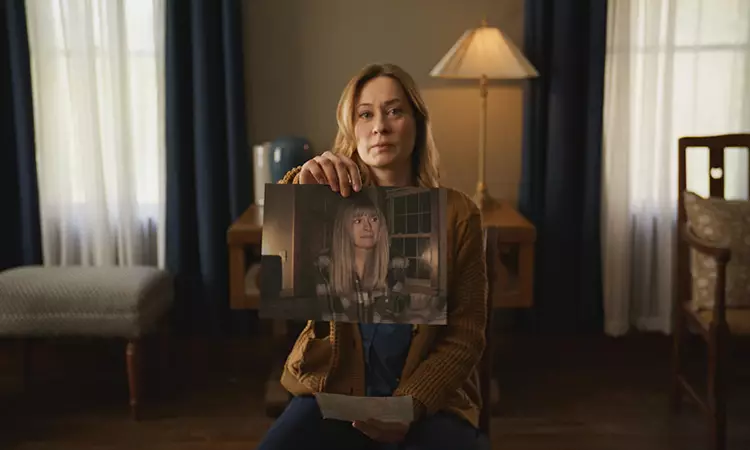In the chilling opening of **Shelby Oaks**, we are confronted with Riley Brennan’s (Sarah Durn) palpable fear articulated through her anxious declaration: “I’m not safe in here. I feel like I’m being watched.” The immediate sense that Riley is enveloped in an unseen menace sets the tone for the intricate interplay of perception and reality at play throughout the film. Ironically, while Riley’s fears fill the auditory realm, they are visually paired with a blank screen, creating a jarring disconnection that prioritizes her subjective experience over a tangible external threat. This duality is amplified as her eventual visual appearance comes with a glitching audio overlay—an unsettling metaphor for the fractured nature of truth in both personal and cinematic narratives.
As viewers, we are led to anticipate a horror story steeped in mythos and mystery, yet we are immediately reminded that what we perceive is often filtered through layers of mediated experiences. The tension between what is seen and heard defines a key thematic undercurrent in the film, suggesting that our understanding of reality is shaped not only by direct experiences but also by the manner in which those experiences are relayed to us.
Chris Stuckmann’s cinematic approach in **Shelby Oaks** draws heavily from the aesthetics and conventions of found footage and true crime documentaries. The film employs a clever narrative strategy by folding Riley’s last moments with her colleagues—Peter (Anthony Bladasare), Laura (Caisey Cole), and David (Eric Francis Melaragni)—into a broader investigation led by Mia (Camille Sullivan), who searches for her missing sister. This method blurs the lines between reality and fiction, immersing the audience in what feels like a fragmented jigsaw puzzle of loss and suspicion.
The existence of bloodshed and horror is suggested through the discovery of the bodies of Riley’s fellow ghost-hunters, a stark contrast to her continuous disappearance. Detective Burke’s (Michael Beach) insistence that Riley is long gone resonates with a chilling inevitability, while the viewer is invited to explore darker truths lurking within the narrative. Here, the omnipresence of digital surveillance and fragmented memories resonates remarkably with contemporary societal fears surrounding privacy and the unknown boundaries of our virtual lives. It offers a haunting meditation on how modern technology often both documents and distorts reality.
As the plot unfurls, the film delves deeper into the relationship between Mia and her sister Riley, evoking themes of familial bonds strained by grief and obsession. Mia’s desperate quest for understanding transcends her personal ties, leading her into a web of eerie revelations about Shelby Oaks—an abandoned town brimming with untold secrets. The tension escalates further as we witness Mia’s solitary investigation, where the narrative shifts to a more visceral portrayal of her encounters without the safety net of a camera crew.
The director’s decision to immerse viewers in Mia’s perspective forms a stark contrast to the coalescing presence of Riley’s past experiences, which are rendered in surreal imagery through cryptic childhood drawings. This displacement of timelines creates a sense of foreboding, suggesting that the ghosts of the past are not merely memories but active participants in Mia’s fate.
Stuckmann’s film serves as a contemporary homage to the psychological tension found in horror classics such as **Rosemary’s Baby** (1968) and **The Exorcist** (1973). Just as those films reflected societal anxieties related to identity and morality, **Shelby Oaks** contemplates the intertwined nature of sisterly and maternal duties amid an overarching horror narrative. The despairing journey of Mia fleshes out the notion that the barriers between motherhood and loss crumble under the weight of unresolved trauma.
**Shelby Oaks** navigates the complex terrain of familial love marred by darkness, locking its audience in a perpetual state of dread while something crucial remains forever elusive. As each layer of the narrative unfolds, we are left to ponder the reality of truth and justice, along with the sinister forces that seem to puppeteer the lives of the characters. Ultimately, this exploration of personal agency within the horror genre encapsulates the ambiguities of human emotion and the terrifying existence of unresolved trauma—a haunting legacy that lingers long after the final credits roll.
In sum, **Shelby Oaks** does not merely recount a story of disappearance; it crafts a richer tapestry woven from the threads of nostalgia, fear, and an unsettling quest for understanding—highlighting the fine line between reality and horror and leaving the audience questioning what haunts us from both the shadows and within ourselves.

